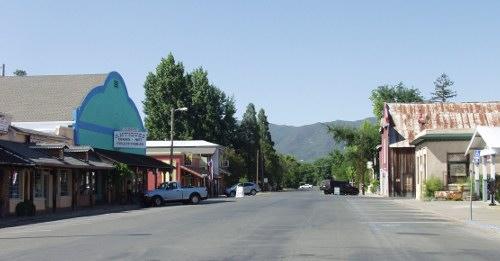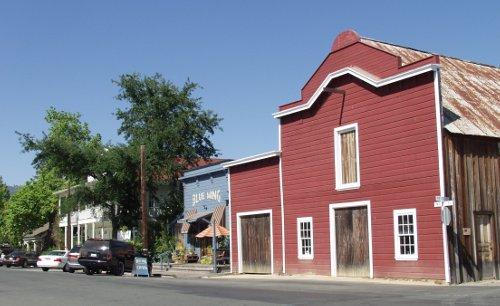
Lake County Redevelopment Agency officials said Upper Lake's improvements began this past week.
Redevelopment agency funds are paying for the $1.3 million project, which will make improvements to both sides of Main Street from the intersection at Highway 20 to the intersection at Second Street.
Officials said the scope of the project includes under-grounding of utilities; curb, gutter, and sidewalk improvements with bulb-out intersections formed from decorative stamped concrete; installation of decorative streetlights; reconstruction of Main Street; and the installation of a welcoming gateway arch across Main Street at the entrance from Highway 20.
While contractor Argonaut Constructors carries out the four-month-long project, it will still be business as usual for local shops, which will keep their doors open, redevelopment officials said.
Full closure of Main Street will encompass just 12 days of the project, according to the redevelopment agency. Traffic control on Main Street will begin on Monday, June 29, and will remain in effect over the course of the project.
The agency said it will issue updates regarding the timing of street closures and alternative parking locations will be made available as the project progresses.
“Once this project is completed, Upper Lake will still have its pioneer charm, but it will be more visible from the highway and the shops will be more accessible to customers and business owners,” said Kelly Cox, the county's administrative officer and executive director of its redevelopment agency.
Cox said the project will make the town “a great place to go for a stroll and enjoy shopping, dining and special events.”
Businesswoman Debbie Hablutzel, president of the Upper Lake Community Council, said they're very excited about the project, which will beautify Upper Lake, draw attention to downtown and light it up with blocks of new streetlights.
She said the council began talking about streetlights 15 years ago, and tried to raise money to do the project on their own.
The lights – which will extend over Main Street and feature small wagon wheels – were folded into the larger project, which she said went through design review in 2002, when the community worked on planning what they wanted.
It was in 2002 that the arch – which will have concrete pillars and a steel structure that passes over Main Street – was designed. Hablutzel said the arch will help draw people to the main part of town and let them know there is actually a town center.
Some people didn't feel the arch was necessary, said Hablutzel. Many people wanted to put it over Highway 20, just as Willits' arch passes over the highway, but Caltrans wasn't open to the proposal.
Despite criticism of the arch, “We weren't going to take it out,” said Hablutzel. “I think once it's done everyone is going to like it.”
The intersection of past and present
Upper Lake, founded as “Upper Clear Lake” in 1854, has always had its own distinctive look and feel – arising from both its twin ranching and timber heritages.
In the past century and a half, the little town has had to be resilient as it has passed through good times and bad.
A new set of historical plaques now grace the town, highlighting interesting facts in the town's fascinating history.
Upper Lake had its first post office in 1858. Other milestones include construction of the original Tallman Hotel in 1866; arrival of the first telegraph lines – stretching from Colusa County to Upper Lake – in 1874; and construction of the Odd Fellows Hall in 1898.
By the 1870s, schools, churches, the grange and the Odd Fellows had arrived. Also in the 1870s, Upper Lake served as the terminus for both the Cloverdale and Clear Lake stage lines, which brought visitors to nearby resorts – Witter Springs and Saratoga Springs, and Le Trianon at Blue Lakes.
But it may have been the many lumber mills in the area that had the greatest impact on the town. A plaque on the building that now houses Gracious Ladies on Main Street explains that by 1870 lumber mills were being built in the nearby Mendocino National Forest. At one time, as many as 42 such mills were in the forest.
Other important industries for the area were dairy farming, with a cheese factory at one point located on Sabini Street, and the Blue Lakes green bean cannery, which started business in 1896.
At one point, Upper Lake had all manner of shops – from dry goods to bakeries to ice cream parlors.
The town had its share of troubles. In 1895 the Tallman House Hotel burned down and later was rebuilt and later renamed for Hank Riffe, the son-in-law of the building's owner, Rufus Tallman, according to a history of the building at www.tallmanhotel.com .
But perhaps the greatest blow to the town was dealt in 1924, when a fire swept through Upper Lake, destroying much of it.
However, one portion of town at First and Main survived – the fire spared the rebuilt Riffe's Hotel and the livery stable next door, the Odd Fellow's Hall, the Bank of Upper Lake and the old ice house across the street. A few blocks away, the Harriet Lee Hammond Library also made it through.
The town rebuilt, and continued to be vibrant for decades. County Deputy Redevelopment Director Eric Seely, who grew up in Upper Lake, said his grandparents came to the area in the 1950s. “At that time Upper Lake was much more vibrant,” he said. “Timber was still a going concern.”
But in the 1970s Upper Lake began to face serious economic challenges, due in part to the depletion of the local timber stands.
“When the timber shut down, a lot of folks retired,” said Seely, and with that properties began to change hands, Main Street businesses closed and many like Seely watched the town go into a slow decline.
Remaining business owners in the 1970s worked to keep it looking look good with new awnings, said Seely. In the late 1980s, Main Street was reconstructed and repaved after the new sewer system was installed. Before that, the streets had been layer upon layer of chip seal.
Seely said he began to see improvements in the town in the 1990s.
Since then new property owners and business people, such as Tony Oliveira, who owns Oliveira's Antiques, and Linda Powell of Powell's Antiques, arrived and began renovating the downtown.
The town took another blow when it suffered a flood on New Year's Eve of 2005. Much of the downtown saw several feet of water flowing through businesses and homes. Once again, the town picked itself up, dusted itself off and got back to work.
Seely credits the town's residents for their work to rejuvenate Upper Lake. “The agency's goals are certainly to assist and partner,” he said.

Rebirth of a historical district
The town's future is closely tied to its past.
In fact, the redevelopment project now getting under way expanded thanks, in part, to investment in that historic core of buildings that survived the 1924 fire.
As business owners began bringing new shops to line the downtown, redevelopment was encouraging renovation of the historical buildings that anchored the far end of town.
Several years ago Sheldon Steinberg purchased and renovated the livery stable, which in the 1880s had been one of three such stables serving the bustling town, according to the new historical plaque gracing the building.
Today, the livery stable houses “The Elegant Bowl,” an antique plumbing fixture business open by appointment and during special occasions such as the recent Wild West Day. A visit inside reveals dozens of ornate clawfoot tubs, delicate porcelain sinks and many a fancy water closet.
Next door to the livery stable had sat the empty Riffe's Hotel. After being purchased at a tax lien sale, the building sat empty for 40 years, looking like a fragile storefront from the set of “Gunsmoke.”
Then Lynne and Bernard Butcher came to the rescue, undertaking a painstaking but ultimately magnificent restoration and expansion. Next door, they built the Blue Wing Saloon & Tavern where once a similarly named establishment was located.
The Tallman Hotel was added to the California Register of Historical Resources as a point of historical interest in 2007. It's widely considered to be one of the Northshore redevelopment area's triumphs.
Across the street, Tom Carter took the old Bank of Upper Lake and renovated it. Today, it is home to Olivia's Organic's, a health food store. On the roof of the building sits a jaunty iron rooster.
The original conceptual plans for Upper Lake's redevelopment project go back several years, said Seely. Those plans stretched from Highway 20 down to Washington Street and included the planned archway at Main Street's entrance into town from the highway.
In 2006, after Deputy Redevelopment Director Andy Peterson retired, Cox and other members of the county's administrative office toured the town and evaluated the project's existing scope, Seely said.
Looking at the investment and improvements by Steinberg, the Butchers and Carter, Seely said county officials decided to add to the project in order to support the community's investment.
“Because of the capital investment the business and property owners were making, we felt it was appropriate to expand the project so that the public and private efforts had a greater synergistic effect than either one by themselves,” said Seely.
Seely credited the Butchers with making a tremendous investment in their property and, as a result, drawing a lot of business to the downtown.
As the project ties the livery stable, Tallman and Blue Wing into the rest of town, it will include better sidewalks and pedestrian access, as well as improvements to parking.
In another tip of the Stetson to the town's heritage, community members asked for the rustic wooden sidewalk in front of the saloon and hotel to remain, and so they were incorporated into the plan design, said Seely.
Argonaut Constructors also will construct samples of sidewalk finish treatments which Seely said community members will help select during the course of the project. Choices will range from concrete that's stamped and dyed to look like wood to use of a weathering technique to make new sidewalks blend in with the older ones that will remain.
Seely said he expects the project will move quickly, as paving will become more challenging as fall and winter arrive.
At the Lake County Wine Studio, across from the Tallman and Blue Wing, proprietor Susan Feiler said she thinks the redevelopment project will help the town. Upper Lake is a great area for business, and she said she hopes to see more shops locating there.
“I have high hopes for this area,” she said. “I really do.”
E-mail Elizabeth Larson at This email address is being protected from spambots. You need JavaScript enabled to view it. .
